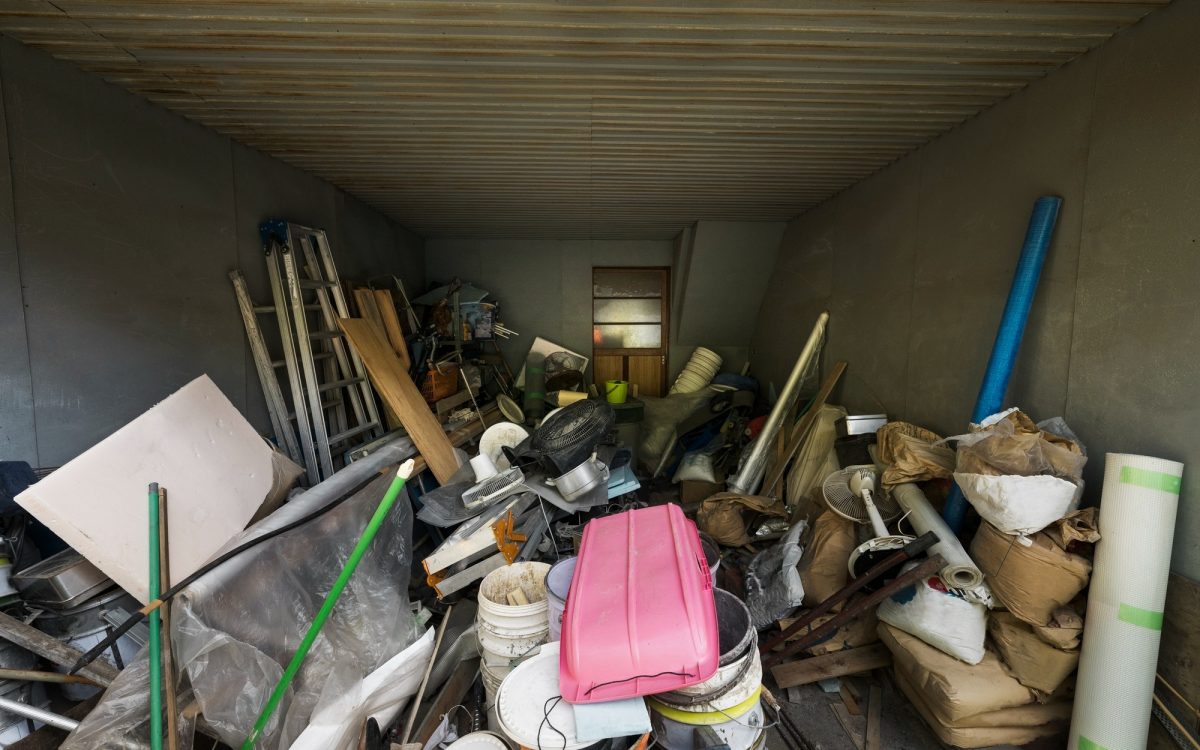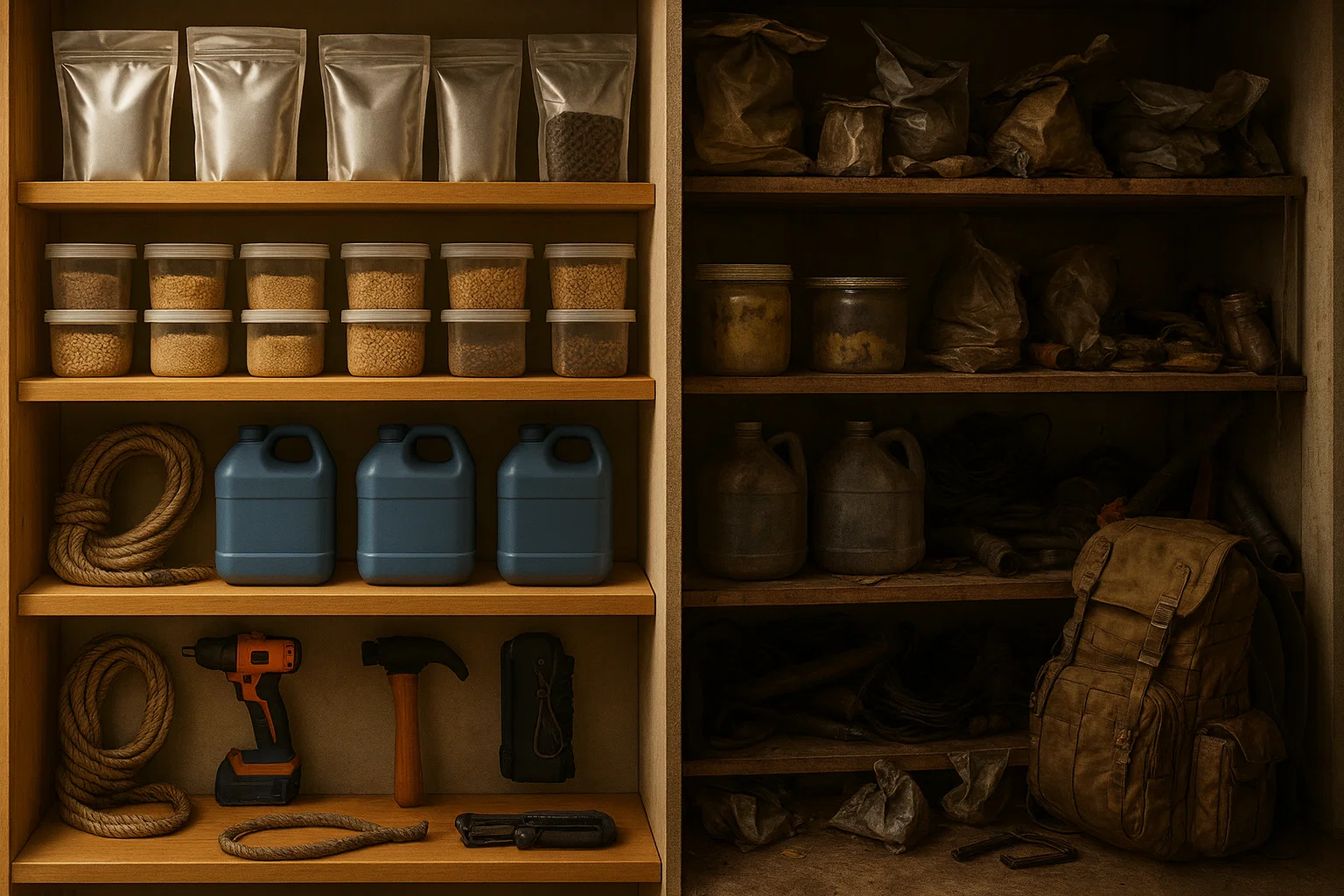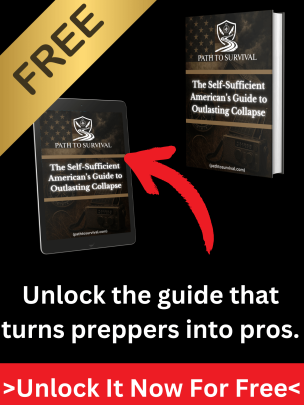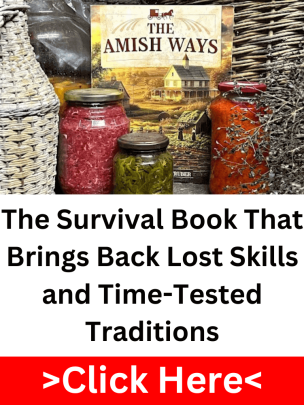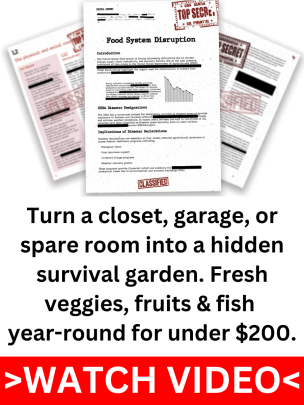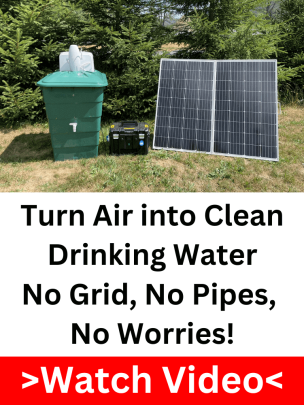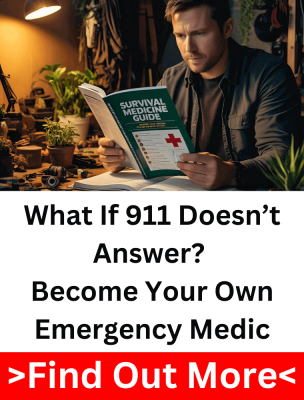When you’re dedicated to preparedness, accumulating supplies is natural. But cluttered spaces can undermine your efficiency during a crisis. Prepping without the clutter is about finding balance, ensuring every item in your prepper stockpile has a purpose. This guide will help you declutter your survival gear while staying ready for any emergency, using strategies to keep your stockpile organized and manageable.
Where to Start
The first step to organizing your prepper stockpile is evaluating the gear and supplies you’ve accumulated. This isn’t just about keeping or discarding items; it’s about ensuring everything has a place and purpose in your preparedness strategy. Start with a thorough inventory check and look at each item to determine whether it serves a vital role in an emergency.
- Essential vs. Non-Essential: Begin by separating items into categories: essentials (like first aid kits, water filters, and non-perishable food) and non-essentials (duplicate tools, outdated gadgets, or items that no longer serve their purpose). Essentials should be items you cannot do without in an emergency situation, while non-essentials are the things you can live without or have in excess.
- Multi-Use Items: Prioritize multi-purpose tools that save space and serve multiple functions, like a multi-tool that combines pliers, knives, screwdrivers, and other small tools. The more functions a single tool performs, the fewer items you need to store in your prepper stockpile.
- Perishable Items: Regularly rotate your stockpile supplies like food, batteries, and other perishables to maintain their viability. Check expiration dates and remove anything that is no longer safe to consume or use. By routinely inspecting these items, you ensure that your prepper stockpile remains clutter-free and effective.
Rotating Prepper Stockpile Supplies
Keeping your stockpile fresh is as important as having it in the first place. Items with expiration dates, emergency food, batteries, medications, need regular rotation. Without a system in place, it’s easy for these items to go unnoticed and become unusable when you need them the most. Here’s how to manage this effectively:
Set reminders on your calendar for quarterly or bi-annual checks. Evaluate each item’s expiration date and replace as needed. This includes not just food but also batteries, medications, and other time-sensitive supplies that can degrade over time. Test tools like flashlights, radios, and water filters to ensure they’re operational. Replace damaged or outdated items to keep your supplies dependable. You don’t want to discover your flashlight isn’t working during a power outage or that your water filter is malfunctioning in a crisis.
Arrange items by category and date, placing those with the closest expiration dates at the front. This makes it easier to rotate items and prevents you from digging through your supplies during an emergency. A consistent rotation schedule keeps your stockpile efficient, ensuring that when you need these resources, they’re in optimal condition. It also keeps you from hoarding supplies that are past their prime, reducing clutter and waste.
Optimizing Prepper Storage Space
A clutter-free prepper setup isn’t just about cutting down on what you have; it’s about making the most of the space you’ve got. Even if you’re working with limited space, using smart storage strategies can allow you to store a surprising amount of supplies. One of the best ways to maximize space is by going vertical. Wall-mounted racks and pegboards are incredibly helpful for keeping your gear organized and easy to reach. Whether it’s tools, flashlights, or first-aid kits, you can hang them up where they’re always accessible.
The beauty of a pegboard is that it’s customizable. You can add hooks, shelves, or baskets depending on your needs, making it a flexible solution for storing various types of gear. As your supplies change or grow, you can rearrange the board to fit your current setup, ensuring that everything remains organized and ready when you need it.
Another excellent way to save space is by utilizing the area under your bed. You can place bins or vacuum-sealed bags there to store items like clothes, blankets, or gear that doesn’t require frequent access. These vacuum bags are particularly great because they compress everything, saving valuable space and keeping your items safe from dust and pests. This is a game-changer, especially for those living in small spaces.
Clear, modular bins are lifesavers when it comes to staying organized. The best part about these bins is that you can see what’s inside without having to dig through them. By labeling them by category, like emergency food, medical supplies, or tools, you can make it easy to find exactly what you need in a pinch. Plus, these bins stack neatly and fit into tight spaces, helping you stay organized without taking up too much room.
Sentimentality vs. Preparedness
Decluttering your prepper stockpile involves some tough decisions. Sentimentality can be a challenge for preppers, but it’s important to distinguish between items that hold true survival value and those you keep for emotional reasons. Holding onto too much can hinder your ability to remain organized and efficient.
- Taking Photos as a Substitute: If you’re holding onto items for the memories, consider photographing them instead of keeping the physical object. This preserves the sentiment without taking up valuable space. For example, if you have old camping gear from past trips that you no longer use, a photo can serve as a reminder of those memories without the physical bulk.
- Eliminating Redundancy: If you have duplicates (like multiple tents or too many flashlights), choose the best one and let the rest go. Selling or donating these items can benefit others who are starting their prepper journey. Streamlining your prepper gear ensures you aren’t overwhelmed with unnecessary extras and that you only keep what you truly need.
Letting go can be difficult, but reducing your stockpile to the essentials makes it more manageable and effective.
Compact and Multi-Use Prepper Gear
Camping gear can quickly take up a lot of space, but that doesn’t mean you have to lug around bulky equipment. By choosing compact, versatile options, you can downsize without losing any functionality.
One great way to cut down on bulk is by selecting multi-use gear. For instance, a multi-season tent or a sleeping bag that works for both summer and winter can cover all your needs. Instead of owning multiple jackets, you could invest in one high-quality, all-weather jacket that handles different climates and activities. This eliminates the need for specialized gear and keeps things simple.
How to Stay Ready Even When You’re Short on Space
When it comes to cooking, opt for a portable cooking system. Compact cooking gear with multi-fuel capabilities is a smart choice. It folds down, taking up minimal space, but still gives you everything you need to cook efficiently outdoors.
Compression bags are another space-saver. Items like jackets and blankets can take up a lot of room, but with compression bags, you can shrink them down to a fraction of their size. This not only helps with space but keeps your items organized and protected from dust and moisture.
By focusing on gear that’s both versatile and space-saving, you’ll keep your setup manageable. You’ll be prepared for outdoor adventures without having to deal with excess bulk or clutter. It’s all about staying efficient while being ready for anything.
Securing Important Documents
Prepping isn’t just about gathering gear; securing your important documents is just as critical. In an emergency, having access to vital records like IDs, property deeds, and medical information can make a world of difference. One smart move is to digitize these documents. By saving copies digitally on encrypted cloud storage or secure USB drives, you ensure you can still access them even if the physical copies are lost or damaged. Make sure these files are encrypted and password-protected to keep them secure.
At the same time, it’s important to minimize the number of hard copies you keep on hand. Only hold onto the most essential documents, and store them in a fireproof and waterproof container. This container should be durable enough to withstand disasters but small enough to grab quickly if you need to evacuate. By streamlining your document setup, you reduce clutter while ensuring your important information is safe and easy to access when you need it most.
Minimalist Prepping Mindset
Adopting a minimalist prepping mindset doesn’t mean compromising preparedness. It means focusing on what’s necessary, functional, and practical for your specific needs. Minimalist prepping is about maximizing efficiency and effectiveness by owning fewer but more versatile items.
Instead of accumulating large quantities of the same item, invest in high-quality gear that lasts longer and performs multiple functions. This reduces the need for backups and duplicates, making your stockpile smaller but more reliable.
- Regularly Reevaluate Your Setup: Make decluttering a regular habit. Each year, reassess your supplies, rotating, discarding, or upgrading items as needed. Keeping your setup lean and efficient will make it easier to manage and ensure you’re always ready.
- Use It or Lose It Mentality: If you haven’t used an item in the past year, consider whether it’s really necessary for your setup. If it’s not, it might be time to pass it on to someone else or donate it. This practice ensures that your prepper stockpile remains relevant to your current needs.
By assessing, organizing, and continually refining your stockpile, you can maintain a clutter: free, efficient, and effective prepping setup. It’s not just about being ready for emergencies but also about living comfortably and efficiently in the present.

